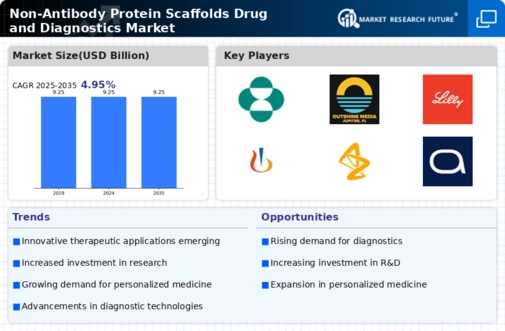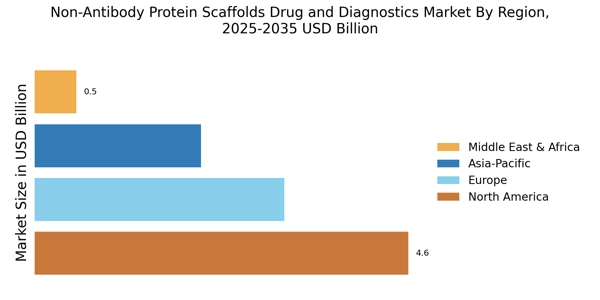Increasing Demand for Targeted Therapies
The Non-Antibody Protein Scaffolds Drug and Diagnostics Market is witnessing a surge in demand for targeted therapies. This trend is largely driven by the growing understanding of disease mechanisms and the need for precision medicine. As healthcare providers increasingly seek to tailor treatments to individual patient profiles, non-antibody protein scaffolds are emerging as viable alternatives to traditional antibodies. These scaffolds offer enhanced specificity and reduced off-target effects, which are critical in the development of effective therapeutics. Market data indicates that the targeted therapy segment is expected to grow at a compound annual growth rate of over 10% in the coming years, reflecting the increasing reliance on these innovative solutions in clinical settings.
Growing Focus on Diagnostics and Biomarkers
The growing focus on diagnostics and biomarkers is reshaping the Non-Antibody Protein Scaffolds Drug and Diagnostics Market. As healthcare systems prioritize early detection and personalized treatment strategies, the demand for innovative diagnostic tools is escalating. Non-antibody protein scaffolds are increasingly recognized for their potential in biomarker discovery and development, offering high specificity and sensitivity. This trend is reflected in the rising number of partnerships between diagnostic companies and research institutions aimed at harnessing these scaffolds for novel diagnostic applications. Market analysts predict that the diagnostics segment will experience a growth rate of approximately 9% in the coming years, driven by the need for more accurate and efficient diagnostic solutions.
Regulatory Support for Innovative Therapeutics
Regulatory support for innovative therapeutics is a key driver in the Non-Antibody Protein Scaffolds Drug and Diagnostics Market. Regulatory agencies are increasingly recognizing the potential of non-antibody scaffolds in drug development and diagnostics, leading to streamlined approval processes. Initiatives aimed at fostering innovation, such as expedited review pathways and incentives for breakthrough therapies, are encouraging companies to invest in non-antibody protein scaffolds. This supportive regulatory environment is likely to enhance the market's growth trajectory, as it reduces barriers to entry for new products. Analysts estimate that the favorable regulatory landscape could contribute to a market expansion of around 8% annually, reflecting the increasing acceptance of these innovative solutions.
Rising Investment in Biopharmaceutical Research
The Non-Antibody Protein Scaffolds Drug and Diagnostics Market is benefiting from rising investment in biopharmaceutical research. Increased funding from both public and private sectors is driving innovation and development in this field. As pharmaceutical companies and research institutions allocate more resources to explore non-antibody scaffolds, the potential for breakthroughs in drug discovery and diagnostics expands. Recent reports indicate that investment in biopharmaceuticals has reached unprecedented levels, with a projected increase of 15% in research funding over the next few years. This influx of capital is likely to accelerate the development of novel therapies and diagnostic tools, positioning non-antibody protein scaffolds at the forefront of medical advancements.
Technological Advancements in Protein Engineering
Technological advancements in protein engineering are significantly influencing the Non-Antibody Protein Scaffolds Drug and Diagnostics Market. Innovations in synthetic biology and computational modeling have enabled the design of highly specific and stable protein scaffolds. These advancements facilitate the development of novel therapeutics and diagnostics that can address unmet medical needs. For instance, the ability to create customized protein scaffolds tailored to specific targets enhances the efficacy of drug candidates. Furthermore, the market is projected to expand as these technologies become more accessible, with an estimated growth rate of 12% anticipated over the next five years, underscoring the transformative impact of engineering on the industry.


















Leave a Comment